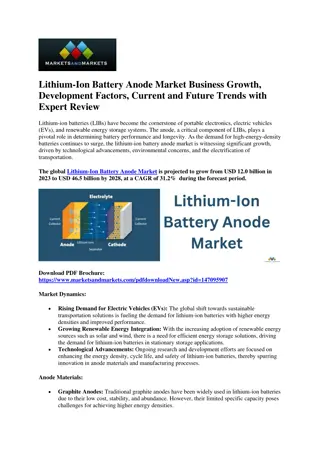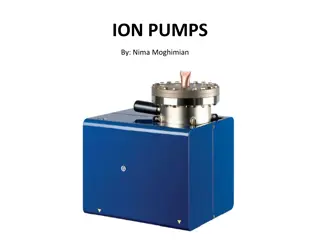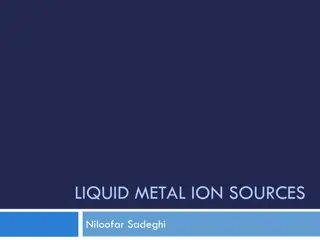Understanding pH Scale and Hydronium Ion Concentration
The pH scale is a logarithmic measurement that indicates the acidity or alkalinity of a solution based on the concentration of hydronium ions. pH values range from 0 to 14, with 7 being neutral. Lower pH values indicate acidity, while higher values indicate alkalinity. This scale provides a convenient way to represent the intensity of acidic or basic properties in a solution. The relationship between pH values and hydronium ion concentrations is essential in chemistry and various scientific disciplines.
Download Presentation

Please find below an Image/Link to download the presentation.
The content on the website is provided AS IS for your information and personal use only. It may not be sold, licensed, or shared on other websites without obtaining consent from the author. Download presentation by click this link. If you encounter any issues during the download, it is possible that the publisher has removed the file from their server.
E N D
Presentation Transcript
pH The numerical values of hydronium ion concentration may vary enormously; for a normal solution of a strong acid the value is nearly 1, whereas for a normal solution of a strong base it is approximately 1 10-14; there is a variation of 100,000,000,000,000 between these two limits. Because of the inconvenience of dealing with such large numbers, in 1909 S renson proposed that hydronium expressed in terms of the logarithm (log) of its reciprocal. To this value he assigned the symbol pH. ion concentration be
Mathematically this is written as This equation can also be displayed as as the logarithm of 1 is zero.
Thus the pH also may be defined as the negative logarithm of the hydronium ion concentration. In general, this type of notation is used to indicate the negative logarithm of the term that is preceded by the p, which gives rise to the following and similarly
This enables the pH of a solution to be considered on a numerical scale from 0 14 and is more convenient in terms of speech, writing and data manipulation. Acidic solutions having a predominance of [H3O+] have pH values between 0 and concentration of pure water, at 25 C, is 1 10-7N, corresponding to a pH of 7. This figure, therefore, is designated as the neutral point, and all values below a pH of 7 represent acidity the smaller the number, the greater the acidity. 7. The hydroniumion
Values above 7 represent alkalinitythe larger the number, the greater the alkalinity. Mathematically there is no reason why negative numbers or numbers above 14 should not be used. In practice, however, such values are never encountered because solutions that might be expected to have such values are too concentrated to be ionized extensively or the interionic attraction is so great as to materially reduce ionic activity.
The pH Scale and Corresponding Hydrogen and Hydroxyl Ion Concentrations
pH 0 1 2 3 4 5 6 7 8 9 10 11 12 13 14 [H3O+] (moles/liter) 100= 1 10-1 10-2 10-3 10-4 10-5 10-6 10-7 10-8 10-9 10-10 10-11 10-12 10-13 10-14 [OH-1] (moles/liter) 10-14 10-13 10-12 10-11 10-10 10-9 10-8 10-7 10-6 10-5 10-4 10-3 10-2 10-1 100= 1 Acidic Neutral Basic
A better definition of pH involves the activity rather than the concentration of the ions: pH= -log aH+ and because the activity of an ion is equal to the activity coefficient multiplied by the molal or molar concentration. Hydrogen ion concentration x activity coefficient = hydronium ion activity
the pH may be computed more accurately from the formula pH= -log ( x c) Hence, the addition of a neutral salt affects the hydrogen ion activity of a solution, and activity coefficients should be used for the accurate calculation of pH. For practical purposes, activities and concentrations are equal in solutions of weak electrolytes to which no salts are added, because the ionic strength is small.
Buffers Buffers are compounds or mixtures of compounds that, by their presence in solution, resist changes in pH upon the addition of small quantities of acid or alkali. The resistance to a change in pH is known as buffer action.
A mixture of a weak acid HA and its ionised salt (for example, NaA) acts as a buffer because the A-ions from the salt combine with the added H+ions, removing them from solution as undissociated weak acid: Added OH-ions are removed by combination with the weak acid to form undissociated water molecules:
A mixture of a weak base and its salt acts as a buffer because added H+ions are removed by the base B to form the salt and OH-ions are removed by the salt to form undissociated water:
The mechanism of action of the acetic acidsodium acetate buffer pair is that the acid, which exists largely in molecular (nonionized) form, combines with hydroxyl ion that may be added to form acetate ion and water; thus, The acetate ion, which is a base, combines with the hydrogen (or more exactly hydronium) ion that may be added to form essentially nonionized acetic acid and water, represented as
The change of pH is slight as long as the amount of hydronium or hydroxyl ion added does not exceed the capacity of the buffer system to neutralize it.
The buffer equation, common ion effect and the buffer equation for a weak acid and its salt The pH of a buffer solution and the change in pH upon the addition of an acid or base can be calculated by use of the buffer equation. This expression is developed by considering the effect of a salt on the ionization of a weak acid when the salt and the acid have an ion in common.
When sodium acetate is added to acetic acid, the dissociation constant for momentarily disturbed because supplied by the salt increases the [Ac-] term in the numerator. To reestablish the constant Ka, the hydrogen ion term in the numerator [H30+] is instantaneously decreased, increase in [HAc]. Therefore, the constant Ka remains unaltered, and the equilibrium is shifted in the direction of the reactants. the weak the acid, is acetate ion with a corresponding
Consequently, the ionization of acetic acid, is repressed upon the addition of the common ion, Ac-. This is an example of the common ion effect. The pH of the final solution is obtained by rearranging the equilibrium expression for acetic acid:
If the acid is weak and ionizes only slightly, the expression [HAc] may be considered to represent the total concentration of acid, and it is written simply as [Acid]. In the slightly ionized acidic solution, the acetate concentration [Ac-] can be considered as having come entirely from the salt, sodium acetate. Because 1 mole of sodium acetate yields 1 mole of acetate ion, [Ac-] is equal concentration and is replaced by the term [Salt]. Hence, the above equation is written as to the total salt
This equation can be expressed in logarithmic form, with the signs reversed, as from which is obtained an expression, known as the buffer equation or the equation, for a weak acid and its salt: Henderson Hasselbalch The buffer equation is important in the preparation of buffered pharmaceutical solutions.
The Henderson Hasselbalch equation is useful also for calculating the ratio of molar concentrations of a buffer system required to produce a solution of specific pH.
The buffer equation for a weak base and its salt Buffer solutions are not ordinarily prepared from weak bases and their salts because of the volatility and instability of the bases and because of the dependence of their pH on pKw, which is often affected by temperature changes. Pharmaceutical solutions for example, a solution of ephedrine base and ephedrine hydrochloride however, often contain combinations of weak bases and their salts. The buffer equation for solutions of weak bases and the corresponding salts can be derived in a manner analogous to that for the weak acid buffers.Accordingly
As [OH-] + [H30+] = Kw [OH-] = KW/[H30+]
Putting the value of [OH-] in the above equation and by rearranging it
Activity coefficients and the buffer equation A more exact treatment of buffers begins with the replacement of concentrations by activities in the equilibrium of a weak acid: The activity of each species is written as the activity coefficient multiplied by the molar concentration.
The undissociated acid, HAc, is essentially 1 and may be dropped. Solving for the hydrogen ion activity and pH, defined as -log aH3O+, yields the equations activity coefficient (activity/conc.) of the
Some factors influencing the pH of buffer solutions The addition of neutral salts to buffers changes the pH of the solution by altering the ionic strength. Changes in ionic strength and hence in the pH of a buffer solution can also be brought about by dilution. The addition of water in moderate amounts, although not changing the pH, may cause a small positive or negative deviation because coefficients and because water itself can act as a weak acid or base. it alters activity
The change in pH on diluting the buffer solution to one half of its original strength is called dilution value. A positive dilution value signifies that the pH rises with dilution and a negative value signifies that the pH decreases with dilution of the buffer.
Temperature also influences buffers The change in pH with temperature is referred to as the temperature coefficient of pH. The pH of acetate buffers was found to increase with temperature, whereas the pH of boric acid sodium borate buffers decreased with temperature. Although the temperature coefficient of acid buffers was relatively small, the pH of most basic buffers was found to change more markedly with temperature, owing to Kw, which appears in the equation of basic buffers and changes significantly with temperature.
Drugs as Buffers It is important to recognize that solutions of drugs that are weak electrolytes also manifest buffer action. Salicylic acid solution in a soft glass bottle is influenced by the alkalinity of the glass. It might be thought at first that the reaction would result in an appreciable increase in pH; however, the sodium ions of the soft glass combine with the salicylate ions to form sodium salicylate. Thus, there arises a solution of salicylic acid and sodium salicylate a buffer solution that resists the change in pH.
Similarly, a solution of ephedrine base manifests a natural buffer protection against reductions in pH. Should hydrochloric acid be added to the solution, ephedrine hydrochloride is formed, and the buffer system of ephedrine plus ephedrine hydrochloride will resist large changes in pH until the ephedrine is depleted by reaction with the acid. Therefore, a drug in solution may often act as its own buffer over a definite pH range.
Such buffer action, however, is often too weak to counteract pH changes brought about by the carbon dioxide of the air and the alkalinity of the bottle. Additional buffers are therefore frequently added to drug solutions to maintain the system within a certain pH range.
pH Indicators Indicators may be considered as weak acids or weak bases that act like buffers and also exhibit color changes as their degree of dissociation varies with pH. For example, methyl red shows its full alkaline color, yellow, at a pH of about 6 and its full acid color, red, at about pH 4. The dissociation of an acid indicator is given in simplified form as
The equilibrium expression is The equilibrium expression can be treated in a manner similar to that for a buffer consisting of a weak acid and its salt or conjugate base. Hence
and because [HIn] represents the acid color of the indicator and the conjugate base [In-] represents the basic color, these terms can be replaced by the concentration expressions [Acid] and [Base]. The formula for pH as derived from equation becomes
Just as a buffer shows its greatest efficiency when pH = pKa, an indicator exhibits its middle tint when [Base]/[Acid] = 1 and pH = pKIn. The most efficient indicator range, corresponding to the effective buffer interval, is about 2 pH units, that is, pKIn 1. The reason for the width of this color range can be explained as follows. It is known from experience that one cannot discern a change from the acid color to the salt or conjugate base color until the ratio of [Base] to [Acid] is about 1 to 10.
That is, there must be at least 1 part of the basic color to 10 parts of the acid color before the eye can discern a change in color from acid to alkaline. The pH value at which this change is perceived is given by the equation. Conversely, the eye cannot discern a change from the alkaline to the acid color until the ratio of [Base] to [Acid] is about 10 to 1, or
Therefore, when base is added to a solution of a buffer in its acid form, the eye first visualizes a change in color at pKIn- 1, and the color ceases to change any further at pKIn+ 1. The effective range of the indicator between its full acid and full basic color can thus be expressed as
Chemical indicators are typically compounds with chromophores (an atom or group whose presence is responsible for the colour of a compound) that can be detected in the visible range and change color in response to a solution's pH. Most chemicals used as indicators respond only to a narrow pH range. Several indicators can be combined to yield so-called universal indicators just as buffers can be mixed to cover a wide pH range. A universal indicator is a pH indicator that displays different colors as the pH transitions from pH 1 to 12. A typical universal indicator will display a color range from red to purple.
For example, a strong acid (pH 03) may display as red in color, an acid (pH 3 6) as orange yellow, neutral pH (pH 7) as green, alkaline pH (pH 8 11) as blue, and purple for strong alkaline pH (pH 11 14).
Some common indicators Color Acid Red Blue Red Yellow Red Yellow Yellow Yellow Yellow Yellow Colorless Yellow Blue Indicator Thymol blue (acid range) Methyl violet Methyl orange Bromcresol green Methyl red Bromcresol purple Bromthymol blue Phenol red Cresol red Thymol blue (alkaline range) Phenolphthalein Alizarin yellow Indigo carmine Base Yellow Violet Yellow Blue Yellow Purple Blue Red Red Blue Red Lilac (light blue) Blue pH range 1.2 2.8 1.5 3.2 3.1 4.4 3.8 5.4 4.2 6.2 5.2 6.8 6.0 7.6 6.8 8.4 7.2 8.8 8.0-9.6 8.3 10.0 10.0 12.0 11.6 14 pKIn 1.5 - 3.7 4.7 5.1 6.3 7.0 7.9 8.3 8.9 9.4 - -
Buffer capacity The magnitude of the resistance of a buffer to pH changes is referred to as the buffer capacity, . It is also known as buffer efficiency, buffer index, and buffer value. Buffer capacity can also be defined as the ratio of the increment of strong base (or acid) to the small change in pH brought about by this addition .
In which delta, , has its usual meaning, a finite change, and B is the small increment in gram equivalents (g Eq)/liter of strong base added to the buffer solution to produce a pH change of pH. According to the above equation, the buffer capacity of a solution has a value of 1 when the addition of 1 g Eq of strong base (or acid) to 1 liter of the buffer solution results in a change of 1 pH unit. Gram equivalent: the atomic or molecular weight divided by the valence.
The buffer has its greatest capacity before any base is added, where [Salt]/[Acid] = 1, and, therefore, according to equation, pH = pKa. The buffer capacity is also influenced by an increase in the total concentration of the obviously, a great concentration of salt and acid provides a greater alkaline and acid reserve. buffer constituents because,
Amore exact equation for buffer capacity The buffer capacity calculated from the following equation is only approximate. It gives the average buffer capacity over the increment of base added. Koppel and Spirol and Van developed a more exact equation,
where C is the total buffer concentration, that is, the sum of the molar concentrations of the acid and the salt. This equation permits one to compute the buffer capacity at any hydrogen ion concentration for example, at the point where no acid or base has been added to the buffer.
Maximum buffer capacity An equation expressing the maximum buffer capacity can be derived from the buffer capacity formula of Koppel and Spirol and Van equation. The maximum buffer capacity occurs where pH = pKa, or, in equivalent terms, where [H3O+] = Ka. Substituting [H3O+] for Ka in both the numerator and the denominator of the equation gives where C is the total buffer concentration






















